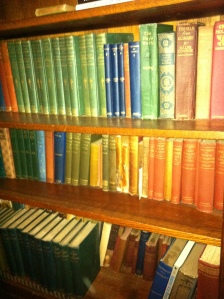Learning to Stay – or Learning Not to Leave
•February 25, 2013 • 2 CommentsInverterted Trust Factor – the Inner Child Trusts the Wrong People
•January 28, 2013 • Leave a CommentInfants All Around Me
•January 15, 2013 • 2 CommentsSo, ever since I realized that my need to be close to a man was an infantile need of rejection and abandonement I see everyone and everything in a new light. I started off my meeting today with my CEO saying – “I’m so tired of everyone being an infant” and he laughed and launched into stories about people in the company being infants…and children…and who was getting fired.
Summer Solstice
•January 14, 2013 • Leave a CommentWe spent a month last summer at the house of Mary Mason in Manomet. The porch was lovely, as was the never ending stream of company that came in and out the door on a continuous basis. There is nothing better than old and new friends mixing and matching.
Hello world! Welcome to the Literary Life of Mary Mason
•June 21, 2011 • 1 Comment
This is just one of the many book cases around the house containing literary gems beyond your imagination!
Welcome to TheLiteraryLifeofMaryMason.com. This blog is a journey that I’ve begun, unexpectedly. In fact, had my sister not rented the John Young house – owned by John Young and Mason Young deep in the woods on the bluff of Manomet, Massachusetts, I never would have known Mary Mason. Or Margaret Young. Or John Young. Or, Mason Young. And actually, aside from seeing them out the window of the house quietly and peacefully playing tennis on the clay tennis court on the slightly overgrown property, I’ve never met John or Mason. Not yet, anyway.
“Looks like everything in the world comes right, if we jus wait long enough.” — Alice Caldwell Hegan – from Mrs. Wiggs of the Cabbage Patch
The beginning: my sister leads me down a rocky, unpaved road off the beachy bluffs of Manomet Ave., to a sharp left at a telephone pole. We go past a rectangle shaped house with a truck in front and a large long rectangular shaped porch off the back.
We drive to the end of the driveway and then onto the long lawn and hence non-existent driveway of one of several John Young related houses that my sister rents and manages on behalf of the owners through her company – www.oceanfrontevents.com. No, this is not an ad. If you go to that site you will see five or six absolutely charming 100 year old houses and a 10 bedroom Inn known as The Idlewild whose front porch overlooks the ocean and Manomet Bluffs. More on the history of the Inn and Manomet Bluffs. Suffice it to say that the Idlewild has a long history, including having been the submit of an Edith Wharton or Edith Wharton era esque novel, which I’ll look up later. It was either called the Doctor, the Beach, or something like that. A one word title. Residents of Boston took a ferry from Boston Harbor right up to the tiny harbor that encompassed the lovely quiet beach of Manomet. It is still serene, hidden and untouched. Unfettered. A peaceful haven away from everything else in the world. A place where time stands still. Where your heart takes a breath when you wake up in the morning and the glorious bright – shining golden sunlight wakes you up at dawn, with waves crashing and sunlight reflecting off the ocean to produce a special quality of light. Northeast beach light. The color is purple yellow – even though those colors cannot be seen. Warm, unique in its own cold New England airy ‘cold’ yet sunny manner.
The John Young house, as my sister called it – was originally going to be her newest project. Her new edition to the cadre of homes and the Inn that she rents by the week, weekend, month, night whatever the renter wishes. These are all charming and historic. The John Young house – which should really be called the Mary Mason and Margaret Young house – was owned and partially occupied by John’s mother (?) Margaret Young up until her death – nearing or around 100 – in 2010. I will find the facts on that, I promise.
This blog is not about Mary Mason or Margaret (Mason?) Young or John Young, who is a writer and has his own literary history. It is about the literary life of Mary Mason.
How could the literary life of Mary Mason matter to anyone? It matters to me. I’m 49 years old. I grew up reading many of the books that I discovered all over Margaret Young’s home. Every wall seems to be lined with bookcases. Most are inscribed as being owned by Mary A. Mason, were given to her, or one or other of her relatives.
In this dusty diamond in the rough of a house, every bookcase is filled with books from the turn of the century (and by that I mean 1900) and before. Not to mention the wonderful colorful novels from the 1930’s and 40’s when book clubs became popular, and even paperbacks into the 1960s and 70s. Every piece in this literary house is a part of the puzzle that enveloped not just Mary Maso, but Margaret Young but her entire family for more than 100 years.
John Young told my sister to ‘Pack up all these books and throw them away.” About that time my sister realized that she was not going to rent the house out at all to vacationers, it required way too much work, but she was going to move in with her little son Brendan and start a new life there. A life that involved cleaning up this massive house and sorting through the details of her own 21 year relationship with the man that she has loved up until this point.
I  started to open up the bookcases and look inside. What I found was honestly, a literary history of the late 1800s and into the 1970s or so, all pulled and picked from the literary viewpoint of first, Mary A. Mason, former head of the Waltham School for Girls. And Margeret Young. A literary roundup of everything from Tennyson to Mrs. Wiggs of the Cabbage patch, to the History of Early English to Reflections of Kant, to The Steam Shovel that Could….and everything imaginable in between.
started to open up the bookcases and look inside. What I found was honestly, a literary history of the late 1800s and into the 1970s or so, all pulled and picked from the literary viewpoint of first, Mary A. Mason, former head of the Waltham School for Girls. And Margeret Young. A literary roundup of everything from Tennyson to Mrs. Wiggs of the Cabbage patch, to the History of Early English to Reflections of Kant, to The Steam Shovel that Could….and everything imaginable in between.
So, I volunteered. Sort of. My body and my mind compelled me to open the books and to start to catalogue, read, intake, envelop and then value each and every book of this collection. Within this dusty, asbestos shingled house lay a treasure trove of books – some rare, some not, some valuable, others valuable only to those who see the value in a book owned by the same family for more than 100 years. Sitting on the same shelf, in the same room, not opened most likely for 70, 80 years. Dust on the covers but perfect, absolutely pristine pages on the inside of these rare, historic, charming, notable works of literature. Mainly originally gathered by Mary A. Mason but clearly carried on by Margaret Young. Somewhere in the house there is a history of Margaret’s life. Now that I’ve catalogued about 30 or so books (our of hundreds) I will have to go back and read about Margaret Young’s life. And will let you know what I find.
In the meantime, tonight I catalogued 10 or 15 books – and of course reading bits and pieces of Tennyson’s Locksley Hall (seems completely and utterly pointless to me but….ok……to Mrs. Woods of the Cabbage Patch by Alice Caldwell Hegan (1903) a quite valueable little book about a mother who loses her (dreadful, alchoholic) husband to the fouls of alchohol…but who despite all of her bad luck in being left to raise her children and run her little cabbage patch alone – always sees the bright side of life. Of things. Instead of complaining about her husbands faults (of which there are many) she says he had such nice penmanship. This is quite an interesting piece of literature to have been written in that era – 1901. I’m sure that the hard times and early deaths that fell upon everyone would be enough to make any of us, now, keel over of sheer horror. However, life had to go on, and Alice had many words of wisdom in this interesting little Tome – such as:
“It is easy enough to be pleasant
When life flows along like a song
But the many worth while is the one who will smile
When everything goes dead wrong.”
Ahhh, Alice, you and I have MUCH in common. Either that or she was truly living on ether if you know what I mean.
You must have had some travails as an adult but yet a good foundation as a child to write that kind of stuff. And you must have had quite a mother – who the book is devoted to – to be able to even state that. And I do agree. I challenge anyone who befalls the death of their husband to alchohol and left to raise her chidren and feed them all alone – in a cabbage patch no less – to wake up every single day with a smile on her face. Wow. I’m so happy I didn’t have to live in 1901.


